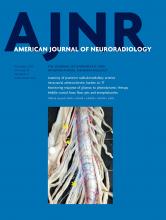Abstract
BACKGROUND AND PURPOSE: Contrast-enhanced MR imaging provides essential information for pediatric imaging applications. We evaluated gadobenate dimeglumine for contrast-enhanced MR imaging of infants younger than 2 years of age.
MATERIALS AND METHODS: Ninety children younger than 2 years of age (including 55 children younger than 1 year) who underwent enhanced MR imaging of the CNS with gadobenate dimeglumine at 0.1 mmol/kg body weight ± 25% by volume were retrospectively enrolled at 2 imaging centers. Safety data were assessed for adverse events and, when available, vital signs and electrocardiogram and clinical laboratory values obtained from 48 hours before until 48 hours after the MR imaging examination. The efficacy of gadobenate dimeglumine–enhanced MR imaging was evaluated prospectively by 3 blinded, unaffiliated readers in terms of the accuracy of combined pre- and postcontrast images relative to precontrast images alone for differentiation of tumor from non-neoplastic disease and the correct diagnosis of specific disease. Differences were tested using the McNemar test. A possible effect of dose on diagnostic accuracy was assessed using the Fisher exact test.
RESULTS: Nine nonserious adverse events were reported for 8 (8.8%) patients. Five adverse events occurred in patients 12 months of age or older. All events occurred at least 24 hours after gadobenate dimeglumine administration, and in each case, the investigating radiologist considered that there was no reasonable possibility of a relationship to gadobenate dimeglumine. No clinically meaningful changes in vital signs, electrocardiogram results, or laboratory parameters were reported. Accurate differentiation of tumor from non-neoplastic disease and exact matching of each specific MR imaging–determined diagnosis with the on-site final diagnosis were achieved in significantly more patients by each reader following evaluation of combined pre- and postcontrast images relative to precontrast images alone (91.0%–94.4% versus 75.3%–87.6%, P < .04, and 66.3%–73.0% versus 52.8%–58.4%, P < .02, respectively). No significant differences (P > .133) in diagnostic accuracy were noted between patients receiving ≤0.08 mmol/kg of gadobenate dimeglumine and patients receiving >0.08 mmol/kg of gadobenate dimeglumine.
CONCLUSIONS: Gadobenate dimeglumine is safe and effective for pediatric MR imaging.
ABBREVIATIONS:
- ECG
- electrocardiogram
- GBCA
- gadolinium-based contrast agent
- Gd
- gadolinium
- © 2019 by American Journal of Neuroradiology












